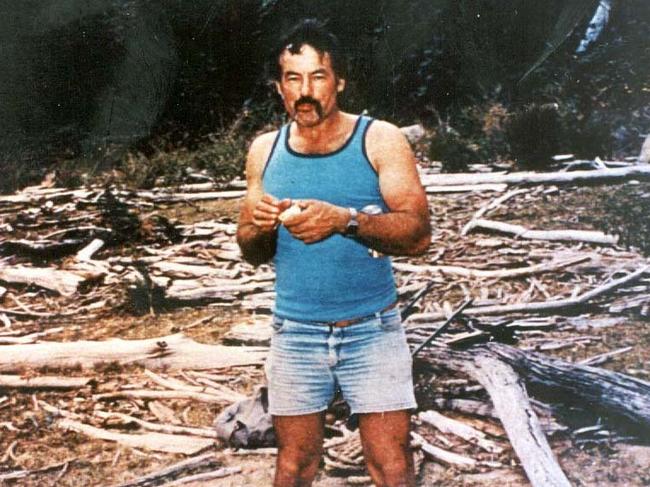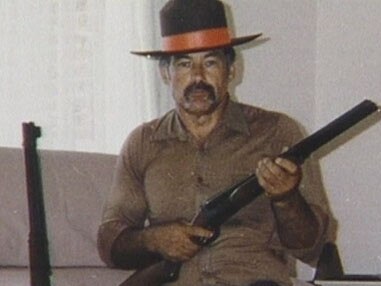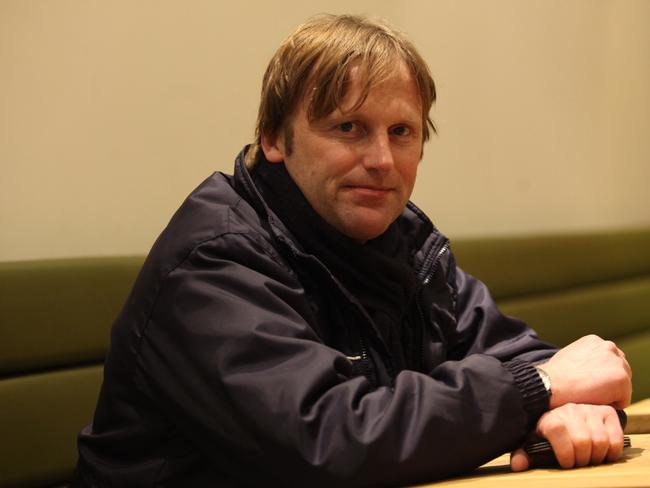How I discovered Ivan Milat was lying: Gary Jubelin
Gary Jubelin’s journey into the heart of evil led him to a repeat offender who was Ivan Milat’s confidant – and who found a ‘glaring’ clue that gave away the serial killer’s crimes.
True Crime
Don't miss out on the headlines from True Crime. Followed categories will be added to My News.
In his new book Badness, former homicide detective GARY JUBELIN investigates what drives people to do bad – and evil – things. Interviewing ex-cops, criminals, psychologists, victims and more, Jubelin begins to see things very differently to his time in the NSW force. In this edited extract he talks to former career crook John Killick – a prison-mate of Australia’s most notorious serial killer, Ivan Milat.
Every prisoner in the High Security Unit at Goulburn prison was kept in segregation, but
John Killick knew Ivan Milat was in there because he could hear him. Unlike some of the others, he was quiet and didn’t argue. But from the way the other prisoners spoke to him, you could tell he had charisma. Sometimes the guards would come and ask him for an autograph.
John would listen to their conversations:
‘How you going, Ivan?’
‘I’m going well. Just working.’

He was working on getting out of prison, John says. It was three years since Ivan had been convicted, in 1996, of murdering two men and five women. The victims were aged between 19 and 22 and disappeared after setting out to hitchhike along the Hume Highway in southwest Sydney. Their bodies were discovered an hour’s drive outside the city, in the Belanglo State Forest. Their murders were so brutal it made you wonder what must have been twisted deep inside their killer to enable him to do it.
Of the seven, two had been shot more than once in the head and one had been decapitated. Three others had stab wounds that would have caused paralysis, with two of these having their spinal cords completely severed. All but one appeared to have been sexually molested, either before or after death. Already, Ivan had made one failed attempt to appeal his conviction and was now working on taking his case to the High Court.
Before his arrival in Goulburn, John had never doubted that Ivan was guilty and he hated him for what was done to those people. But after several months in that strange place, listening to the voices of the men locked in the cells around him, Ivan became the person to whom John was closest.

It happened when the guards moved him to the Multi-Purpose Unit and asked if he wanted to go outside twice a week into the prison yard and walk around with another inmate.
Yeah, John said. Because naturally you’d want to after months inside with nobody to talk to. But the guards said the only inmate he could walk round with was Ivan. All the others were on strict protection.
So it was Ivan or nothing. John told himself that he needed to talk to someone.
OK, then. He’d do it. He would talk to Ivan.
***
‘In jail, you learn,’ John tells me now, as we sit facing each other in a cafe. ‘Over the years I’ve come across so many murderers who did horrific things. You come to accept them.’
That first day, when the guards led John out into the daylight, Ivan was standing, waiting. John says he had narrow eyes and a thin, mean smile.

John stuck out his hand and Ivan took it.
John told Ivan, ‘I just want you to know that what you did was a horrific crime.’
‘I agree,’ Ivan replied. ‘If I’d have done it, John, I’d be a monster.’ The smile again, just like a knife’s edge. ‘Only, I didn’t do it.’ They started walking round the yard together.
For months, the two men met up often. Ivan could hold his own when they were talking. He was charming. Both knew the other was facing a long stretch inside prison, so there was little to gain from trying to protest their innocence but, still, Ivan insisted.
‘He said, “Look, I didn’t do it”,’ John says. But John already knew enough about the murders from reading about them in the papers to have his doubts. He asked Ivan about the evidence
the cops found when they raided his home in Eagle Vale: the gun parts, including a firing pin that matched the bullet casings recovered from the Belanglo State Forest; the silencer; the
tent that once belonged to one of the murdered backpackers.

‘That was planted, John. All that stuff was planted’, Ivan told him.
John looked at him and didn’t think that Ivan looked like he was evil. Nor did he look like he was innocent.
‘Look, I’ll prove it to you,’ said Ivan and told John about the court transcripts from his trial, which he had access to in prison because he’d been working to challenge his conviction. There were pages where the prosecution had a witness, Paul Onions, who had been hitchhiking on the Hume Highway around the time of the murders. Paul’s evidence was that a man had given him a lift, but had then pulled out a revolver and said he was going to rob him. Paul fled, leaving his rucksack behind. Asked in court to describe his attacker, Paul said he had a moustache like the cricketer Merv Hughes and was driving a white or silver four-wheel drive, maybe a Nissan or Toyota. Ivan had a moustache like cricket star Merv Hughes and drove a Nissan Patrol, the court heard.

Paul had also said the car that picked him up had chrome wheel trims and a spare wheel attached to the back door. During the trial, Paul was shown a photo of Ivan’s four-by-four, which had chrome trims and a spare wheel. It matched his description.
Then Ivan’s lawyer told the court those trims and that spare wheel had been added only after the date Paul claimed he was hitchhiking on the Hume Highway. Paul’s memory must be
mistaken, Ivan told John. It couldn’t have been Ivan’s truck that picked him up. It could not have been Ivan.
‘He nearly swung me. He nearly swung me,’ John says. ‘Because of what he showed me, he started to put doubts in my mind.’
***
On their walks round the yard together, John learned more about Ivan. He was one of 14 children. His mum, Margaret, had been 14 when she met his dad Stephen, a Croat who was
more than twice her age and himself one of 22 children, only four of whom survived through infancy.
By the time they had their eighth child, Stephen was drinking heavily. He’d whack Margaret and call her angry names. She would threaten to leave him. To their neighbours, the kids seemed sombre, scowling and closed-minded. If they acted up, their parents flogged them.
Stephen and Margaret had more children. The family lived near the army reserve at Holsworthy where they all slept in a two-room shack with a dirt floor and where mealtimes often descended into conflict.

Stephen would lash out, saying that the food wasn’t ready or that he didn’t like it. More than once, he reached down and flipped the table over, sending plates, cups and frightened
children spinning across the room around him.
One time, their neighbours watched as Stephen delivered a public beating to two of his boys, who lay on the ground beside the shack while he went at them with a length of timber.
I wonder if this violence got passed down through the family. Whether it was something Ivan’s father gave his boys, like their dark hair or black tempers. Or did the fact his father beat him mean something inside Ivan got broken? Is that enough to explain why he grew up to use violence against others?
But then, John Killick saw violence growing up with his alcoholic stepfather. So did another former crook I am interviewing, Bernie Matthews. Neither of them became killers.
By the age of seven or eight, Ivan was working long, grinding hours alongside his brothers and his father, growing tomatoes. One summer, their tomato crop was stolen. That meant financial disaster. Stephen went back to labouring, this time at a concrete manufacturer.
With their dad gone all day, the kids ran wild. Ivan started to play truant from school and, around the time he turned a teenager, one of his teachers recommended to his parents that their son be sent to Boys Town.

Run by the Salesian Order of Catholic priests, Boys Town was meant to provide a safe home for wayward boys. It was only decades later that the reports of children being beaten and
raped by the adults who ran it began to be told in public. Ivan always claimed to have enjoyed his time there but his offending got worse after. He did burglaries and armed robberies, getting caught and later sent to the Mount Penang Training School for Boys on the Central Coast. Decades later, just like Boys Town, people started telling stories about Mount Penang. Of children being stripped, beaten and raped.
Ivan never told these stories but, even without them, Mount Penang sounded rough. Ivan had his 18th birthday inside and, when he got out in early 1963, he started causing trouble again, only this time it was wilder – dong smash-and-grabs and packing guns. Ivan got caught often, like John Killick, and spent time in and out of prison.
Like John, Ivan might come out and go straight, finding some work labouring, until the money didn’t fit his lifestyle. Crime paid. Ivan spent time in Parramatta Gaol, in Long Bay, at Emu Plains prison farm, at Grafton: release, reoffend, get sent back to prison. John had gone through the same cycle.

On their walks around the prison yard together, John started thinking, maybe Ivan was right. Maybe he had been fitted up by some bent coppers. John had seen it happen. Maybe Ivan didn’t do those murders. They were both facing decades in prison, so why would Ivan lie to John? And Ivan was insistent.
***
In all, Ivan Milat went to court seven times to challenge his conviction. Each time, he repeated what he said to John Killick in the yard at Goulburn; that he couldn’t have been the killer.
At different times he said that he could not have been the man identified by the surviving witness, Paul Onions, because his truck didn’t have chrome trims or a spare wheel on the back door. He argued about DNA evidence taken from hairs found in the hand of one of the victims, which did not match his own. In court, his barrister argued that, while the prosecution had established that the murders were carried out by someone who was part of or close to the Milat family, it wasn’t Ivan.

No judge was convinced by Ivan’s claims of innocence: every one of his applications for an inquiry was rejected.
As for that evidence about the chrome wheel trims and the spare tyre, it remains unexplained. Possibly a trick of memory. But it was not enough to overturn the other mass of evidence linking Ivan to the attack on Paul, which one judge described as ‘remarkable in its breadth and detail’.
John, too, now accepts Ivan was guilty. For him, the moment of realisation came in prison, after he and Ivan had been moved to different facilities, and John used the prison library to get hold of a transcript of Ivan’s evidence in court.
‘I went through it and what I found was a glaring omission in our conversations,’ John tells me. ‘Every day one of those victims went missing, Ivan had a day off.’
He laughs. ‘The odds of that,’ he says. ‘I’m a gambler and I know odds.’ By then, he says, he trusted Ivan. The two of them were writing to each other, with Ivan offering to help challenge John’s conviction. ‘I cut it off and I wrote him a letter saying, “Look, don’t write to me again.”’
‘Do you see him as evil?’ I ask John.

‘Yes, I do. Definitely,’ he answers. ‘I think, on the inside, there are just some people who are beyond redemption. It’s not just their childhoods, their upbringing, whether they found themselves rejected. Ivan was mistreated as a child, but so were his brothers and sisters.’
This is my sixth lesson about badness. That different people might have the same life stories, but not all of them will go on to do evil.
Badness by Gary Jubelin will be published by HarperCollins on September 7 and is available to pre-order here now. Hear more from Gary and his guests at I Catch Killers, wherever you get your podcasts.
More Coverage
Originally published as How I discovered Ivan Milat was lying: Gary Jubelin




